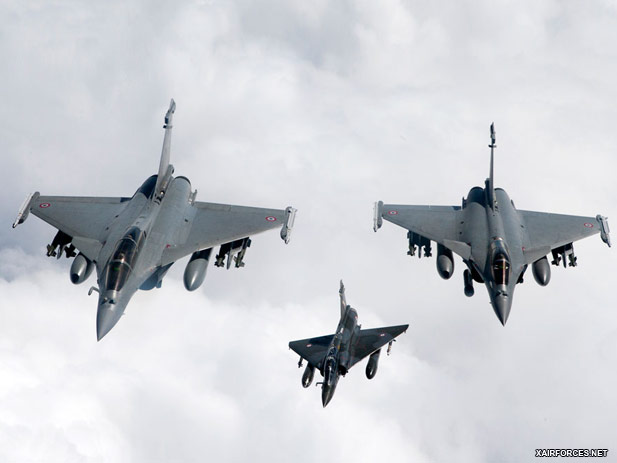
NATO’s Role in Ghaddafi’s Downfall: Operation Unified Protector

British, French and U.S. aircraft began the action in mid-March, in a “coalition of the willing” named Operation Odyssey Dawn that was led by U.S. Africa Command. On March 31, NATO took command. Eleven other nations sent aircraft to join the campaign. They were Belgium, Canada, Denmark, Italy, Jordan, Norway, Qatar, the Netherlands, Spain, Sweden and the United Arab Emirates.
But it seems only the U.S. had the firepower to ensure that the essential first objective of suppressing Libyan air defenses was achieved. By the eighth day of the campaign, the U.S. had fired 184 BGM-109s Tomahawk cruise missiles from ships and submarines against radars, surface-to-air missile sites and communications nodes. As for Libyan air bases, there was one attack by three American Northrop B-2s, flying 24-hour round-robin mission from their home base in Missouri. The Stealth Bombers were employed as much for their ability to each drop 15 independently targeted JDAM bombs on hardened aircraft shelters, as for their stealth capability
Having spent some $400 million in the first week alone, the U.S. ended strike missions after 17 days. But American air support remained vital, including: aerial refueling (KC-135s), electronic warfare (EA-18Gs); maritime patrol (P-3s); psychological operations (EC-130s), search and rescue (MV-22s); surveillance (E-8 JSTARS and Global Hawk ) and SIGINT (RC-135s and EP-3s). An MV-22 retrieved the crew of a U.S. Air Force F-15E that crashed in Libya on March 21 after a “technical malfunction.”
NATO commanders hoped that the initial air strikes against the regime forces attacking civilians, combined with rapid advances made by the rebels, would either cause Ghadaffi to sue for peace or for his regime to collapse. However, as the rebel advances were reversed and cities like Misrata remained under constant bombardment NATO realized that the strategy to protect civilians needed to be adjusted in order to erode the ability of the regime forces to cause harm. This required more air strikes to degrade the regime’s ability to command and control its forces, and to disrupt the supplies destined for those forces attacking or threatening to attack civilians. NATO and key participating countries denied that regime change had become the goal, although that outcome became increasingly likely. Even after the action was over, the NATO commander, Lt. Gen Charles Bouchard, insisted: “We stayed focused on the [United Nations] mandate, and stayed well within it.”
The air strikes were stepped up. The majority of them were flown by the UK and France, which used Dassault Rafales and Mirage 2000Ds based in Crete and Italy, plus Rafales plus Super Etendards embarked on the aircraft carrier Charles de Gaulle. French warplanes started and finished the air action over Libya. On March 19, they were the first to attack Kaddafi forces threatening Benghazi. On October 19, they attacked the convoy in which Colonel Ghaddfi attempted to break out from his last stronghold of Sirte.
But the small deployments of F-16s by Denmark and Norway made a significant contribution, according to outgoing U.S. Secretary of Defense Robert Gates. Belgium, Canada, Italy, Qatar and the UAE also flew strike missions. Dropped from the UAE’s Mirage 2000-9s, the MBDA PGM-500 Hakim weapon made its combat debut. Swedish Gripens flew reconnaissance missions as well as air defense missions. In early June, British and French attack helicopters joined the action, from ships stationed offshore.
During the operation, NATO flew more than 26,000 sorties, including more than 9,600 strike missions (although many of these did not actually drop weapons). To direct this huge effort, the CAOC in Italy expanded quickly from 100 to nearly 400 staff. Lt. Gen. Bouchard praised “the very careful targeting process” and the “courageous restraint and professionalism of the aircrews.”
Military analysts are now assessing the campaign. It is clear that the prompt application of airpower saved the citizens of Benghazi from murderous revenge. Within three weeks, moreover, the Ghadaffi armed forces could no longer maneuver conventionally. Thereafter, they used concealment and guerilla tactics. But NATO had enough persistent intelligence, surveillance and reconnaissance assets to keep track of them–notably the Predator UAVs provided by the U.S. They were joined in August by Italian Reaper and French Harfang (Heron) UAVs, but only the American Predators fired weapons–Hellfire missiles on more than100 occasions.
Was airpower the decisive factor and was NATO’s intervention in Libya therefore a model for the future? Commented British Air Marshall Sir Stuart Peach: “Each operation is unique. We will take key lessons from this, but we must not try to ‘retro-fight’ every campaign.”
Source: November 10, 2011 - Dubai Air Show - by Chris Pocock (http://www.ainonline.com)
Photo: The majority of Libyan air strikes were flown by the UK and France, using Dassault Rafales and Mirage 2000D (April 2011. © Ministere de la Defense)
(19.11.2011)
|